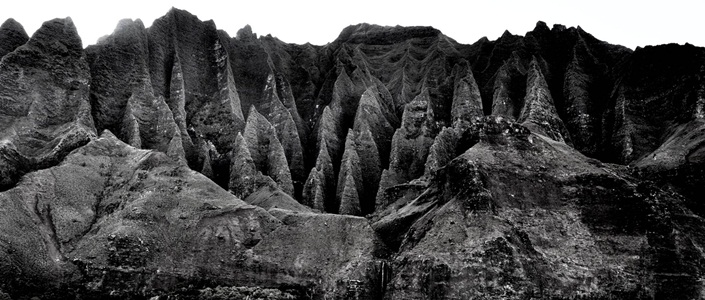Kauai is the oldest island in the chain making it one of the most beautiful and diverse of the Hawaiian Islands. Kauai nicknamed the Garden Island for its lush vegetation and abundant rainfall is home to many indigenous plants and wildlife. The island of Kauai is circular in shape and covers approximately 550 square miles.
Kauai is a volcanic island, rich with rain forest, swamp lands, lush valleys, waterfall lined craters, dramatic coastlines as well as the longest white sand beaches in all of Hawaii. Kawaikini Peak is Kauai’s highest point at 5,148 feet and has been known as the wettest spot on Earth, with over 400 inches of rain per year. The most spectacular geographical landmarks on Kauai are the Napali Coast and the Waimea Canyon State Park.
The eight main Islands of Hawaii(Big Island), Maui, Kahoolawe, Lanai, Molokai, Oahu, Kauai, and Niihau are the tallest mountains of an extensive range covering nearly 3,500 miles of the Pacific Ocean basin. Commonly known as the Hawaiian-Emperor volcanic range, these mountains span from the southeast corner of Hawaii(Big Island) past midway and bend north across the pacific ending in close proximity to the Aleutian Islands of Alaskan. The 350-mile stretch of mountain peaks we know as the Hawaiian island chain stand alone as one the most isolated Archipelago in the world.
The Emperor Sea mounts and Hawaiian Island chain associated with this volcanic range are formed by a fixed position magmatic hot spot, which has continually spewed molten magma from the earths mantle for the past 70 million years. The Pacific Ocean tectonic plate slides northwest 3-6 inches a year, and this movement creates new volcanic mountains to the Southeast while the older mountains travel farther from their source. Above this hot spot the youngest, tallest mountains of the chain are found on Hawaii (Big Island). Mauna Kea and Mauna Loa summits are just short of 14,000 feet. If measured from the seafloor both mountains prize more elevation than Mount Everest.
Kilauea, at nearly 4,000 feet, sits below Mauna Kea and Mauna Loa and is home to Volcano National Park, the only place flowing lava can be witnessed in the Islands. Each Hawaiian island is unique in nature due to its specific age in geologic time. Kauai is the oldest of the eight main islands. Wave action, wind and water erosion have carved once cone shaped volcanoes into what Kauai is today, the lush green Garden Isle.
The powerful low pressure weather systems in the north pacific generate large high interval swells which bombard the Na Pali coastline shaping majestic cliff lines from the oceans edge. The Hawaiian chain also sits in the center of the strongest trade wind belt in the northern hemisphere producing fairly consistent wind direction and speed throughout the year. As warm, moist trade winds reach land they produce rainfall, which overtime has carved Kauai into a masterpiece of physical geography with more abundant fresh water streams than the sum of all other island in the state. Four of the sixteen climates found globally are within the islands 550,000 square miles of terrain. This geographical diversity has proved Kauai is an outdoor adventurers dream destination, but also offers recreation for all walks of life.


